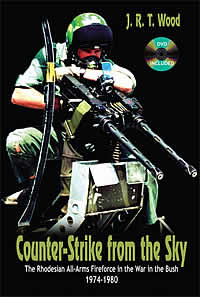On 11 November 1965, Rhodesian Prime Minister Ian Smith unilaterally declared his country independent of Britain. International sanctions were immediately instituted against the minority white regime as Robert Mugabe’s ZANLA and Joshua Nkomo’s ZIPRA armies commenced their armed struggle, the ‘Chimurenga’, the war of liberation. As Communist-trained guerrillas flooded the country, the beleaguered Rhodesians, hard-pressed for manpower and military resources, were forced to devise new and innovative methods to combat the insurgency. Fireforce was their answer …
Fireforce as a military concept dates from 1974 when the Rhodesian Air Force (RhAF) acquired the French MG151 20mm cannon from the Portuguese. Coupled with this, the traditional counter-insurgency tactics (against Mugabe’s ZANLA and Nkomo’s ZIPRA) of follow-ups, tracking and ambushing simply weren’t producing satisfactory results. Visionary RhAF and Rhodesian Light Infantry (RLI) officers thus expanded on the idea of a ‘vertical envelopment’ of the enemy (first practised by SAS paratroopers in Mozambique in 1973), with the 20mm cannon being the principle weapon of attack, mounted in an Alouette III K-Car (‘Killer car’), flown by the air force commander, with the army commander on board directing his ground troops deployed from G-Cars (Alouette III troop-carrying gunships and latterly Bell ‘Hueys’ in 1979) and parachuted from DC-3 Dakotas. In support would be a propeller-driven ground-attack aircraft armed with front guns, pods of napalm, white phosphorus rockets and a variety of Rhodesian-designed bombs; on call would be Canberra bombers, Hawker Hunter and Vampire jets.
By the winter of 1976, the ZANLA High Command and, to a lesser degree, ZIPRA had begun saturating the border regions of Rhodesia with their insurgent forces. In the Operation Thrasher area alone, on the eastern frontier with Mozambique, Special Branch estimates of enemy strength numbered over 3,000 ZANLA guerrillas. Facing them were the territorial soldiers of the 4th Battalion, Rhodesia Regiment, a company of Rhodesian African Rifles, a commando of Rhodesian Light Infantry, a troop of Selous Scouts and a battery of antiquated 25 pounders—all in all, perhaps, no more than 500 men on the ground.
To deal with the threat, the Fireforce based at Grand Reef, near the border town of Umtali, could muster four Alouette gunships, one Lynx propeller-driven ground-attack aircraft and 12 airmobile troops as the first-wave reaction force. Dakota DC-3 ‘ParaDaks’ in 1977 and Bell ‘Hueys’ in 1979 boosted the Fireforce capacity considerably; however the odds worsened for the beleaguered Rhodesians during the final years of hostilities.
In spite of the overwhelming number of enemy pitted against them, Rhodesian Fireforces accounted for thousands of enemy guerrillas, with a kill ratio exceeding 80 : 1. At the end of the war, ZANLA generals admitted their army could not have survived another year in the field—in no small part due to the ruthless efficiency of the Fireforces, described by Charles D. Melson, the Chief Historian of the U.S. Marine Corps, as the ultimate “killing machine”.
Included in the book is a minute-by-minute account of Operation Dingo—Fireforce ‘writ large’ with the airborne assault in Mozambique. On 23 November 1977, the Rhodesian Air Force and 184 SAS and RLI paratroopers attacked 10,000 ZANLA cadres based at ‘New Farm’, Chimoio, 90 kilometres inside Mozambique. Two days later, the same force attacked 4,000 guerrillas at Tembué, another ZANLA base, over 200 kilometres inside Mozambique, north of Tete on the Zambezi River. Estimates of ZANLA losses vary wildly; however, a figure exceeding 6,000 casualties is realistic. The Rhodesians suffered two dead, eight wounded and lost one aircraft. Operation Dingo, essentially a massive Fireforce operation, became the prototype for all major Rhodesian cross-border raids.
§ Back to list
|







